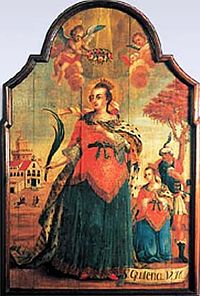Quiteria
Saint Quiteria | |
|---|---|
 18th-century Brazilian image of Saint Quiteria. | |
| Martyr | |
| Died | 5th century traditionally Aire-sur-l'Adour |
| Venerated in | Roman Catholic Church Eastern Orthodox Church[1] |
| Major shrine | Aire-sur-l'Adour |
| Feast | 22 May |
| Attributes | palm of martyrdom; depicted with a dog on a lead; depicted with her head in her hands, emerging from the sea. |
| Patronage | invoked against rabies;[2] Higueruela; Meca (Alenquer) |
Saint Quiteria (Template:Lang-es; Template:Lang-ca; Template:Lang-oc; Template:Lang-fr; Template:Lang-pt; Template:Lang-ta) was a 5th-century virgin martyr, about whom nothing is certain except her name and her cult. She appears in the Roman Martyrology, but not in any other ancient calendars (such as the Martyrologium Hieronymianum).
Name
Quiteria may be derived from Kythere (or Kyteria, Kuteria), a title applied to the Phoenician goddess Astarte which meant "the red one",[2] or from (the possibly related name) Cytherea, an epithet of the Greek goddess Aphrodite, given because she was born on the island of Cytherea. Such origins of the name suggest to some that Saint Quiteria is fictional.
Legend
Her legend states that she was the daughter of a Gallaecian prince. Her father wanted her to marry and renounce Christianity. Quiteria fled and her father's men found her at Aire-sur-l'Adour, in Gascony. She was beheaded on the spot. Her sister Saint Libérate also suffered the same fate, was beheaded in the forest of Montus and lies in a 14th-century sarcophagus in the fortified church of Saint Jean Baptiste, Mazéres 32 km from her sister Quiteria in Aire-sur-l'Adour.
Quiteria and the nine nonuplet sisters
Portuguese religious traditions state that Saint Quiteria was the leader of the "Nine Nonuplet Sisters," who were named Eumelia (Euphemia); Liberata (Virgeforte); Gema (Marinha, Margarida); Genebra; Germana; Basilissa; Marica; and Vitoria (Victoria). These were born in Minho to an important Roman military official. Their mother, disgusted at the fact that she had given birth to nine daughters all at once as if she were a common peasant (or an animal), ordered a maid to take them to a river to drown them. Their father was unaware of their birth.
Disobeying her mistress, however, the maid gave the girls over to some local women who brought them up. As adult women, they opposed the worship of Roman gods and were brought before their father, who recognized them as his daughters. Their father wanted them to marry Roman officers or other suitors. The nonuplets refused and were imprisoned in a tower. However, they escaped and liberated all of their other prisoners. They subsequently waged a guerrilla war in the mountains against the Roman Empire.
Quiteria was caught and beheaded. Her sister Euphemia, unable to escape from the soldiers who pursued her, threw herself from a cliff situated today in the Peneda-Gerês National Park (it is called today Penedo da Santa, Cliff of the Saint). A rock opened up and swallowed her and on the spot there sprang up a hot spring.
This is a legend that closely follows that of the Galician Saint Marina, who is said to have been one of nine sisters. (citation needed)
Patron Saint of rabies
Alternate legend
Other Portuguese traditions make her a native of Bracara (Braga, Portugal) who was decapitated and thrown into the sea. This legend states that she emerged from the water with her head in her hands, and is thus sometimes represented as such. However, she is not considered one of the Cephalophores because there is no written record to support this. Her patronage against rabies stems from the fact that her legend states that she held two rabid dogs at bay with the power of her saintly voice. A festival in her honor was first held at Tui, Galicia in 1688 after a proclamation was made by its bishop.[3]
Gallery
-
Sainte-Quitterie church, Aire-sur-l'Adour, France
-
A Roman capital in Sainte-Quitterie church
-
A Roman capital in Sainte-Quitterie church
-
Church of Saint Quiteria (Santa Quiteria) in Alcázar de San Juan, Spain.
-
Church of Archista Kitheriammal (Saint Quiteria) in Manakarai, Tuticorin District, Tamil Nadu, India.
References
- ^ Template:Gr icon Ἡ Ἁγία Κουϊτερία ἡ Μάρτυς. 22 Μαΐου. ΜΕΓΑΣ ΣΥΝΑΞΑΡΙΣΤΗΣ.
- ^ a b portcult.com
- ^ http://arre-burro.weblog.com.pt/arquivo/2004_10.html





